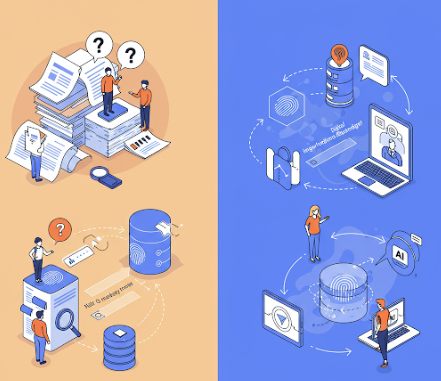March 26, 2025
Slash Costs and Boost Loyalty with AI-Powered Documentation
Remember the early internet, when websites were mostly static “brochureware”? This evolved into e-commerce. The brochureware approach proved surprisingly effective for customer support. It allowed companies to put product documentation, HR manuals, and engineering notes online where people could reference them. Later, search capabilities were added, making this content more accessible. A fundamental challenge remained: search alone couldn’t bridge the gap between complex documentation and user needs.

This limitation became increasingly apparent as documentation libraries grew. Subject matter experts (SMEs) could now share knowledge widely. Users faced a new problem: navigating vast repositories of technical information. Even with search capabilities, customers and employees found themselves wading through dense, jargon-heavy documents. They struggled to find precise answers to their questions. Finding that crucial piece of information felt like searching for a needle in a haystack. The result? Frustration, costly support calls, and even product returns.
What if we could end that hunt entirely? We can transform static documentation into something far more powerful. An interactive, intelligent system that acts as your company’s always-on digital expert. Instead of just pointing to documents, this system provides precise, instant answers in clear, natural language. It works regardless of the user’s preferred language. It can find the needle in the haystack instantly! This isn’t a distant dream. It’s achievable today through modern AI. It delivers measurable ROI through reduced support costs, fewer returns, and higher satisfaction among both customers and employees. The question is: how do we make this transformation from static content to dynamic expertise?
The key lies in moving beyond traditional keyword matching to truly understanding the meaning behind questions and content. We use powerful AI tools called Large Language Models (LLMs) like ChatGPT, Claude, or Gemini. Simply using these tools isn’t enough. They need to be enhanced with crucial context about your specific business and documentation.
When a customer asks a question, our AI system doesn’t simply pass their raw inquiry to the language model. Instead, it constructs a dynamic briefing package containing three essential components. First, operating parameters that define the AI’s role and tone. Second, relevant contextual information pulled specifically for this query from your business documentation. Third, the customer’s original question. This complete package—the prompt—focuses the AI engine to deliver responses using only your approved information. This delivers relevant, controlled answers aligned with your company’s expertise. To make this work effectively, we need to carefully manage how much information we feed into the AI’s “working memory” at once.
The “working memory” of an AI, known as itscontext window, determines how much information it can process at once. Modern AI models can handle impressive amounts of text (up to 128,000 tokens) in this window, but efficiency remains crucial. The key is providing only the most relevant context for each query, as this helps maintain accuracy while keeping processing costs manageable.
This is whereText Embeddingsact as our intelligent librarian’s card catalog. These embeddings create unique digital “fingerprints” that capture the core meaning of text chunks, allowing us to match similar ideas even when they’re expressed differently. For example, “graphics card help” and “video card support” would generate similar fingerprints. These fingerprints are stored in aVector Database– think of it as a sophisticated index that organizes ideas rather than just words.
This idea index powers a process called Retrieval-Augmented Generation (RAG). When a user asks a question, RAG first creates a fingerprint for that question’s meaning. It then rapidly searches the Vector Database to find the document chunks with the most closely matching fingerprints. This retrieves the most relevant snippets of your actual knowledge.

RAG then provides only this relevant, retrieved information to the LLM within a carefully crafted set of instructions called a Prompt. The prompt guides the AI, telling it to generate an answer based solely on the trusted company information provided. It’s like giving a brilliant research assistant the exact pages they need. This process guarantees their answer is accurate, relevant, and grounded in your reality.
A RAG system works in three steps:
- Step 1: Convert user’s question into an embedding (digital idea finger print)
- Step 2: Search the vector database to find matching document chunks (uses the idea index)
- Step 3: Feed these chunks + instructions (the prompt) into the LLM ‘s context (working memory) to generate a final answer
RAG systems can be enhanced with advanced techniques. One key method, HyDE (Hypothetical Document Embeddings), improves search precision by imagining an ideal answer first. It then uses that answer’s fingerprint to find relevant matches. This solution-focused approach often yields better results than searching directly with the user’s question. HyDE is just one example of these enhancements. Even basic RAG implementations deliver strong business value.
How do these advancements translate into the business wins executives care about? Let’s break down the tangible returns you can expect from implementing AI-powered documentation:
- Accuracy That Builds Trust: Customers find exact solutions at 2 AM, straight from your vetted documentation. No more waiting for support to open.
- Dramatic Cost Savings: Support costs decrease as AI handles routine queries. Expect a significant reduction in support tickets within 90 days.
- Customer Loyalty Boost: 24/7 instant answers keep customers satisfied and loyal. Replace frustrating delays with immediate solutions.
- Universal Understanding: AI adapts complex documentation for every user level, from beginners to experts. This provides clear communication.
Imagine customers instantly resolving product issues or employees getting immediate clarity on HR policies. This happens 24/7, without human intervention. This isn’t just a chatbot. It’s a virtual subject matter expert, always available, fluent in your company’s specific knowledge.
Implementing a RAG system isn’t just another AI initiative. It’s your strategic advantage in today’s knowledge-driven economy. By transforming your existing documentation into dynamic, AI-powered assets, you’ll dramatically enhance customer satisfaction while slashing operational costs. As competitors inevitably adopt these capabilities, delaying means surrendering your competitive edge. Just as the early internet transformed static brochureware into dynamic e-commerce, today’s AI can transform your documentation into a strategic asset. By acting now, you’re not just keeping pace. You’re positioning your company as a leader in AI-driven efficiency and customer satisfaction. You’re saving money, building loyalty, and future-proofing your business. Start today, see the ROI tomorrow, and lead the future of knowledge management with confidence.

(This series will continue, exploring specific implementation strategies, comparisons like RAG vs. Conversational AI, and advanced techniques like graph-enhanced retrieval.)
TweetApache Spark Training
Kafka Tutorial
Akka Consulting
Cassandra Training
AWS Cassandra Database Support
Kafka Support Pricing
Cassandra Database Support Pricing
Non-stop Cassandra
Watchdog
Advantages of using Cloudurable™
Cassandra Consulting
Cloudurable™| Guide to AWS Cassandra Deploy
Cloudurable™| AWS Cassandra Guidelines and Notes
Free guide to deploying Cassandra on AWS
Kafka Training
Kafka Consulting
DynamoDB Training
DynamoDB Consulting
Kinesis Training
Kinesis Consulting
Kafka Tutorial PDF
Kubernetes Security Training
Redis Consulting
Redis Training
ElasticSearch / ELK Consulting
ElasticSearch Training
InfluxDB/TICK Training TICK Consulting

